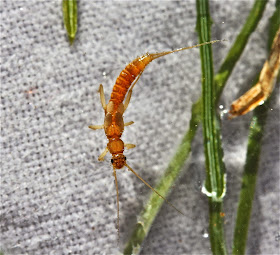Saturday, February 7, 2015
The small winter stonefly Paracapnia angulata: going higher in Sugar Hollow
A beautiful spot: higher up than I've gone on this stream before.
I worked hard today to locate new things, digging into the substrate, but most of the insects I've seen here before. One exception: the small winter stonefly, Paracapnia angulata.
We've found them before on the other side of the valley (see, for example, 1/30/12), but further down in this stream, I've seen nothing but the more common small winter, genus Allocapnia. The main difference, you may recall, at least in making a real quick ID -- the shape of the rear wing pads. On Allocapnia nymphs, the posterior edge of the rear wing pads is truncate (flat),
on Paracapnia nymphs, they're more rounded off.
Today is the first time that I've noted the "parentheses" on the terga -- they showed clearly on segments 4-7 -- but when I looked at my photos from previous years, I could see them on the live nymphs as well. (Visible on terga 2-8)
While Allocapnia nymphs have a tolerance value of 3.3 (North Carolina values), Paracapnia angulata hasn't been rated. That normally means it's not seen that often. Habitat? "Nymphs typically occur in small headwater streams, possibly in leaf packs." (Beaty, "The Plecoptera of North Carolina," p. 1) That's affirmative.
_________________
A few other findings -- photos that turned out alright.
1. Perlodid stonefly, Isoperla similis. Not uncommon in these headwater streams, but overall not very common.
2. Uenoidae, Neophylax mitchelli, tolerance value of 0.0.
This one has clavate ventral gills and a sharp tubercle on its head (visible in this photo), one that tends to point to the rear. Also, light colored legs and normally a light colored face, and 1-3 setae in the ventral sa3 position.
Not the best photo -- but good enough.
3. Roach-like stonefly, genus Tallaperla. Keep looking for the species that has only one gill sticking out behind the rear wingpads (Viehoperla ada): still haven't found one.










No comments:
Post a Comment